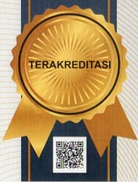Hidrolisis Limbah Kulit Nanas dengan Asam Asetat Menggunakan Metode Ultrasound-Assisted Acid Hydrolysis (UAAH) untuk Produksi Oligosakarida
Abstract
Pineapple peel waste has a lot of fiber and carbohydrate content so that it has the potential to become raw material for making oligosaccharides. Oligosaccharide production can be done through hydrolysis with acidic compounds. This research aims to determine the effect of ultrasonic waves application in acid hydrolysis to pineapple peel waste. Hydrolysis was carried out with 0.5 M acetic acid with variations in volume of 10, 15, 20, 25, and 30 mL as well as variations in the time of use of ultrasonic waves for 5, 10, 15, 20, and 25 minutes. The results of hydrolysis showed varying Rf in the analysis using thin layer chromatography (TLC).Based on Rf, oligosaccharides have been produced (Rf ≤ 0.64), including the smallest solvent volume (10 mL) and the shortest duration of ultrasonic wave application (5 minutes).
Keywords : Pineapple peel waste, ultrasound-assisted acid hydrolysis, oligosaccharides, prebiotic
ABSTRAK
Limbah kulit nanas memiliki banyak kandungan serat dan karbohidrat sehingga berpotensi menjadi bahan dasar pembuatan oligosakarida. Preparasi oligosakarida dapat dilakukan melalui hidrolisis dengan senyawa asam. Penelitian ini bertujuan untuk mempelajari efek penerapan gelombang ultrasonik dalam hidrolisis asam terhadap limbah kulit nanas. Hidrolisis dilakukan dengan asam asetat 0,5 M dengan variasi volume 10, 15, 20, 25, dan 30 mL serta variasi waktu penggunaan gelombang ultrasonik selama 5, 10, 15, 20, dan 25 menit. Hasil hidrolisis menunjukkan Rf yang beragam pada analisis menggunakan kromatografi lapis tipis (KLT). Berdasarkan Rf, oligosakarida telah dihasilkan, termasuk dengan volume pelarut terkecil dan durasi aplikasi gelombang ultrasonik yang paling singkat.
Kata kunci : Limbah kulit nanas, ultrasound-assisted acid hydrolysis, oligosakarida, prebiotik
Full Text:
PDF (Bahasa Indonesia)References
. U.N. Nastiti, N. D. R. Lastuti, and T. Nurhajati, “The Decreasing of Crude Fiber and The Increasing of Crude Protein Content of Pineapple Peel (Ananas Comosus L. Merr) Which Fermented by Cellulolytic Bacteria (Actinobacillus Sp. Ml-08)”, Agroveteriner, vol. 1, no.2, pp. 46-54, 2013
. cendananews.com, https://www.cendananews.com/2017/10/2018-balikpapan-tambah-10-hektare-tanam-buah-nanas.html, diakses tanggal 20 Agustus 2019
. A. Upadhyay, J. P. Lama, and S. Tawata, “Utilization of Pineapple Waste: A Review”, J. Food Sci. & Technol. Nepal, vol. 6, pp. 10-18, 2010
. G. R. Gibson and R.A. Rastall, Prebiotics : Development & Application. Chicester : John Wiley & Sons, 2006
. D. Santos, U. F. Silva, F. A. Duarte, C. A. Bizzi, E. M. M. Flores, P. A. Mello, “Ultrasound-assisted acid hydrolysis of cellulose to chemical building blocks: Application to furfural synthesis”, Ultrason. Sonochem, vol. 40, pp. 1-88, 2018
. M. Toma, M. Vinatoru, L. Paniwnyk, and T. J. Mason, “Investigaton of The Effect of Ultrasound on Vegetal Tissue During Solvent Extraction”, J. Ultrasonic Sonochemistry, vol. 8, pp. 137-142, 2001
. I.A. Saleh, M. Vinatoru, T. J. Mason, N. S. Abdel-Azim, E. A. Aboutabl, and F.M. Hammouda, “A possible general mechanism for ultrasound-assisted extraction (UAE) suggested from the result of UAE of chlorogenic acid from Cynara scolymus L. (artichoke) leaves”, J. Ultrasonic Sonochemistry, vol. 31, pp. 330-336, 2016
DOI: https://doi.org/10.32487/jst.v5i2.747
Refbacks
- There are currently no refbacks.
Copyright (c) 2019 JST (Jurnal Sains Terapan)
View My Stats


